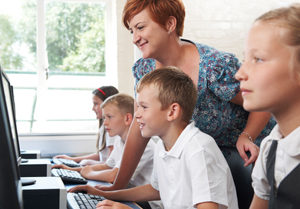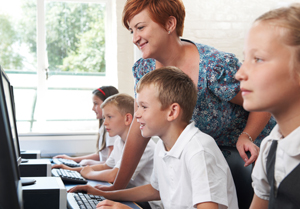
Differentiating between real and fake news is a good first step in arming students to question the media they encounter. The next step in our world of democratized but not always fact-checked digital media is to ensure they have the critical-thinking skills to evaluate what they’re seeing online.
Helping students become media literate
 Media Smarts, Canada’s Center for Digital and Media Literacy, says media literacy means being able to analyze, evaluate and produce media content. This may seem simple, but the rhetorical skills required to actively engage media are not necessarily clear to students.
Media Smarts, Canada’s Center for Digital and Media Literacy, says media literacy means being able to analyze, evaluate and produce media content. This may seem simple, but the rhetorical skills required to actively engage media are not necessarily clear to students.
Teachers can use a variety of lessons to help students understand the media they encounter. Media Smarts’ Five Key Concepts for Media Literacy are helpful for constructing lessons for students:
- Media is made
- Audiences help make it
- Media content is often linked to monetary profit
- Media is influential — socially and politically
- Context of media influences its form
Here’s a look at five potential media-literacy lessons:
1. Media production
This exercise helps students understand that authoring is an act of deliberate construction.
- Divide the students into groups.
- Have them describing something — perhaps your classroom or a complex image you provide — but limit their time and word count.
- Give different groups specific outlooks: happy, sad, frustrated, etc.
- Have groups come together to share their descriptions and talk about why they included specific details and left others out.
- Look at two or three sample news articles that cover the same topic but provide different details. Have groups discuss why this might happen.
2. Media audiences
This lesson illustrates how publications connect with their audiences.
- Have students read a restaurant review from the perspectives of multiple personas: college student, wealthy businessman, vegetarian, or someone with medical or religious dietary restrictions. You can identify the persona for them or have them think of their own.
- Lead a conversation about how the article satisfies or fails to address the needs and interests of each of those perspectives.
- Have students modify their pieces to satisfy an assigned audience.
- When they’re finished, have them share their work, discuss the original audience and reflect on how it feels to be an “ignored” reader.
3. Media sponsorship
This activity helps students see the role of money in media.
- Assign them to survey several websites and try to identify how they make their money. Because it often uses corporate sponsorship, Buzzfeed can be an interesting inclusion, but don’t forget news sites with paywalls (like the New York Times or the Wall Street Journal) as well as sites that use fundraising or public funds (like NPR).
- After students identify a site’s funding structure, have them examine articles there and write a short reflection on how they think that funding might influence editorial decisions.
4. Media influence
This assignment helps show students the social and political influences of media.
- Have them examine famous images and discuss their influence on a viewer’s thoughts and memories. For example, they can be given iconic photographs of social or political movements (e.g. civil rights protesters, clashes with police, Lyndon B. Johnson’s “Daisy” ad).
- Have the class explore who is present, who is absent, and how these images portray the people in the pictures.
- Challenge students to write about how the presence or absence of specific people in the media may have lasting social or political consequences.
5. Media form and context
Our next lesson can be a powerful project for helping groups, pairs or individual students understand the many forms of information expression. Audiences and information outlets often have a profound influence on how information is presented — whether in mobile websites, Twitter feeds, Facebook posts or blogs. This activity helps students analyze an audience and decide on the best content form to reach that audience.
- To start, enter the room with jars labeled audience (i.e., parents, teachers, politicians, students, Generation X, millennials, Greatest Generation, etc.), medium (i.e., print, digital, video, etc.), and topic.
- Students should use these randomly drawn assignments to decide how to create a project that they think best communicates to the audience through the medium provided. The results should be a variety of projects — ranging from blogs to YouTube clips to posters.
- End the exercise by having students show their work when they are finished and explain why they chose a specific form when creating the project.
Media literacy should be everywhere
However you teach students about media literacy, make it a consistent conversation where they engage the textbooks, announcements, newspaper and digital content via your teaching or their own research. You don’t have to confine these conversations to specific media literacy lessons. Instead, help students see media literacy as a skill they can improve every day to become better scholars and citizens.
Monica Fuglei is a graduate of the University of Nebraska in Omaha and a current faculty member of Arapahoe Community College in Colorado, where she teaches composition and creative writing.
Categorized as: Tips for Teachers and Classroom Resources
Tagged as: Engaging Activities, Language Arts, Professional Development
